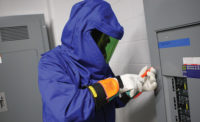"Boomeritis" isn't our word. In 2001 the American Academy of Orthopaedic Surgeons and the American Orthopaedic Society for Sports medicine developed a public education program — "Boomeritis" — to increase awareness of the growing number of sports-related injuries among baby boomers.
By the way, most sports-related injuries to boomers are minor bruises and sprains from bicycling, running, skiiing and in-line skating. A Yale orthopaedic surgeon estimated the number of these boomer bumps and bruises at 90,000 injuries a year.
And interestingly, boomers are PPE-resistant off the job. Only 43 percent wear bike helmets.
But this not another article about the aging workforce. About how baby boomers (born between 1946 and 1965 and totaling about 79 million) across the nation are boosting employers' worker's comp claims with their accumulated aches and pains.
All that really needs to be said about that came from an article in 2000 in the magazineRisk & Insurance:"Many boomers will work well beyond the traditional retirement age, a fact that promises to impact workplace injuries and claims costs."
Indeed, in the Bureau of Labor Statistics' count of days away from work injuries and illness in 2005, the 45-54 age group ranked third among age categories, with 282,310 cases. Combine that figure with the 135,290 cases in the 55-64 age group and more than 400,000 boomers lost work time in '05 to injuries.
"Studies show most employers are not planning for the aging baby boomer generation," the article reported. "The trend toward longer working lives and greater employer reliance on older employees has significant cost implications."
MENTAL STRESS
No, this edition ofISHN's ezine is not about the need for more ergonomic programs and wellness activities, beneficial as they can be. Or about being more proactive in implementing solutions and programs to accommodate aging boomers.
We're looking at "boomeritis" as a mental state of mind more than a physical condition.
The last thing a safety and health pro wants is a distracted workforce. It's all about safety awareness, safety consciousness, THINK SAFETY, be your brother's and sister's keeper. Lately the eastern concept of "mindfulness" has popped up in safety literature and workshops. Be aware, very aware and alert, moment to moment.
But all those boomer workers — one writer in The Progressive magazine says they should be called Geezer Boomers, no longer Baby Boomers — have much on their minds.
Many can't hear well in a restaurant or party after years of rock concerts and loud music. I had a friend in college who scribbled on many of his albums (remember vinyl?) PLAY IT LOUD. Now, according to a recent New York Times report, about one in six boomers have hearing loss. The AARP says there are more people age 45 to 64 with hearing loss (10 million) than there are people over 65 with hearing loss (9 million).
"None of us protected our ears at all," said rocker Pat Benatar.
Said a stay-at-home mom who returned to the work force after 14 years: "In meetings, I wasn’t' catching everything."
Vision is going, too. How dangerous is it when boomers (old schoolers without the benefit of GPS) are driving and squinting to read roadmaps with their tiny highway numbers?
"The AT&T White Pages phone book is shrinking," complained a reader to The Kansas City Star blog. "Increase the tiny font size to where it used to be so that we baby boomers with bifocals can read the names and numbers without a magnifying glass!"
While hearing and eyesight might be fading, waistlines are expanding. "Today's Baby Boomers Are Heavier And More Likely To Have Arthritis," headlined a 2005 press release from Boston's Beth Israel Deaconess Medical Center. And that's despite all those gym memberships boomers have. The obesity epidemic is nationwide, but baby boomers got a much earlier start, said the report.
Or as Margie Geiser, a fitness coach, wrote on her blog, "In America, try walking to work or to the local store! It's either impossible or just too unsafe.
"Overall, (boomers) are less active in their daily lives than their parents."
ISSUES & ILLS
If you want an idea of the issues and ills boomers are dealing with, watch any edition of CBS Evening News. (Does anyone under age 45 watch the evening news anymore?) The broadcasts are dominated by commercials for high blood pressure, high cholesterol, impotence, insomnia, prostate problems and so on.
Then there are the issues weighing on the minds of boomers. Shuttling back and forth between the melodramas and safety of their own teenagers, and the needs and safety of their elderly parents.
You have the sticker shock of college tuition bills. Followed possibly by empty nest post-traumatic stress syndrome.
Retirement. Should we down-size? Move to Vegas? Will we ever be able to retire?
Techno-stress. Some boomers qualify as "legacy dinosaurs," entrenched to resist any change. Others are fumbling with text messaging (hopefully not while driving). Or figuring out all the features of the new iPhone.
Maybe all this explains why a federal study found 568,000 Americans age 55 or older used illicit drugs in the past month, according to a 2002 report in the Christian Science Monitor. The number is expected to rise significantly in the next decade as baby boomers age, according to the report.
A federal program found that between 1995 and 1999, alcohol was the primary problem for more than 50,000 people who checked into publicly funded treatment centers. But during that time, alcohol admissions dropped by nine percent while admissions for illicit drugs increased by 43 percent for women and 25 percent for men in that age group.
Yes, boomers have a lot on their minds, a lot to cope with. Something to consider the next time you give a SAFETY FIRST pep talk or launch into an explanation of mindfulness.
By Dave Johnson
Boomeritis - a new safety risk?
